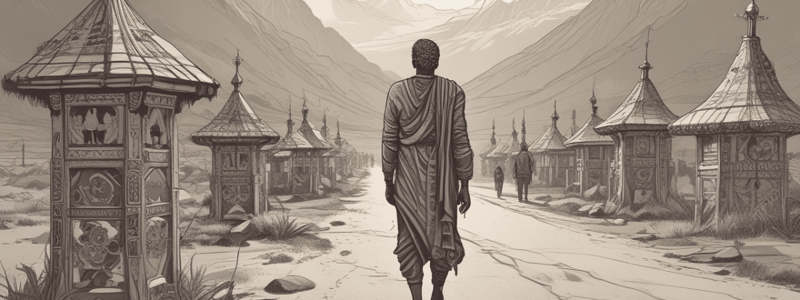Podcast
Questions and Answers
What did George Murdock search for in 1945?
What did George Murdock search for in 1945?
- Cultural universals across hundreds of communities (correct)
- Cultural differences between communities
- The impact of technology on material culture
- The role of humour in releasing social tensions
What is a common feature of all societies, according to George Murdock's findings?
What is a common feature of all societies, according to George Murdock's findings?
- The regulation of sexual reproduction and the upbringing of offspring (correct)
- A uniform family structure
- A universal method for teaching kids to use the bathroom
- A single method for burying the dead
What is the term used to describe the inconsistency between rapid technological advancements and slower changes in nonmaterial culture?
What is the term used to describe the inconsistency between rapid technological advancements and slower changes in nonmaterial culture?
- Material culture
- Social tension
- Cultural change
- Cultural lag (correct)
What is an example of a cultural universal?
What is an example of a cultural universal?
Who coined the term 'cultural lag'?
Who coined the term 'cultural lag'?
What is a characteristic of cultural universals?
What is a characteristic of cultural universals?
What is the main difference between material and nonmaterial culture?
What is the main difference between material and nonmaterial culture?
What is the main idea behind cultural lag?
What is the main idea behind cultural lag?
Who wrote about the importance of humour in releasing social tensions?
Who wrote about the importance of humour in releasing social tensions?
What is an example of a cultural universal that is not uniform across cultures?
What is an example of a cultural universal that is not uniform across cultures?
What typically happens to the nonmaterial culture when the material culture undergoes transformation?
What typically happens to the nonmaterial culture when the material culture undergoes transformation?
What is the main reason why people still go to the doctor's office despite advances in technology?
What is the main reason why people still go to the doctor's office despite advances in technology?
What is high culture typically associated with?
What is high culture typically associated with?
What is the purpose of aesthetic gatekeepers according to Shrum (1991)?
What is the purpose of aesthetic gatekeepers according to Shrum (1991)?
What does folk culture encompass according to Real (1977)?
What does folk culture encompass according to Real (1977)?
What is the characteristic of popular culture according to Bogart (1991)?
What is the characteristic of popular culture according to Bogart (1991)?
What is the main theme of the book 'Wallbangin' by Susan Phillips (1999)?
What is the main theme of the book 'Wallbangin' by Susan Phillips (1999)?
What is the main idea behind the phrase 'All things shall pass'?
What is the main idea behind the phrase 'All things shall pass'?
What is the main difference between high culture and folk culture?
What is the main difference between high culture and folk culture?
What is the main characteristic of cultural diversity in the twentieth century?
What is the main characteristic of cultural diversity in the twentieth century?
Study Notes
Culture Universals
- Anthropologist George Murdock searched hundreds of communities to find cultural universals, discovering that all societies engage in similar behaviors, but with unique practices.
- Examples of cultural universals include family structures, funeral customs, and taboos against incest.
- Despite differences, all human cultures have funeral customs to deal with death, and humor to release social tensions.
Cultural Lag
- William Ogburn coined the term "cultural lag" to describe how technology advances quickly, but nonmaterial culture (ideas) takes longer to catch up.
- Material culture (items) changes quickly, while nonmaterial culture lags behind, causing an inconsistency in a cultural system.
- An example of cultural lag is how we can diagnose illnesses using computers, but our traditions (nonmaterial culture) have not kept up with technology.
Culture, Class, and the Media
- Herbert Gans identified three "taste cultures" in the 20th century: high culture, folk culture, and popular culture.
- High culture: associated with the upper classes and intelligentsia, requiring extensive education and resources, and seen as a social sign of sophistication.
- Folk culture: encompasses activities and creations of working-class and minority groups, impulsive, familiar, and useful.
- Popular culture: includes items that appeal to the population as a whole, often criticized for favoring "vulgarity" and "the commonplace".
Cultural Change: Today and Tomorrow
- All aspects of culture are subject to change, and when one aspect changes, others follow.
- Cultural integration: the intimate ties between diverse components of a cultural system, exemplified by how changes in women's employment affect family structures and marriage ages.
- Human history will continue to change as long as humans exist, and cultural change will continue to occur.
Studying That Suits You
Use AI to generate personalized quizzes and flashcards to suit your learning preferences.
Description
Explore the concept of cultural universals, where all human societies share similar behaviors, and cultural lag, a phenomenon where cultural values lag behind technological advancements.




